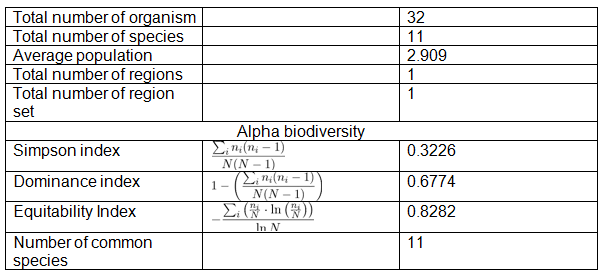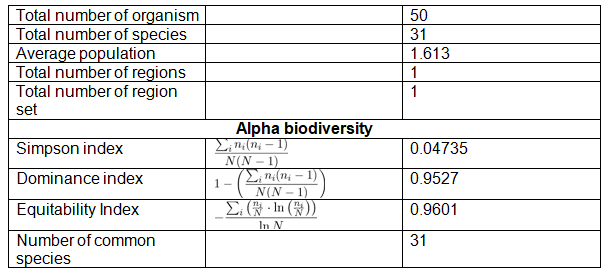Introduction
This experiment was conducted to determine and measure the level of species diversity in two habitat areas. The two areas include forest and urban ecosystem. Biodiversity can be described by determining the number of species in an ecosystem. It also refers to as species richness. In general, the diversity of species includes both the richness and evenness of species.
Evenness compares the resemblance of the size of population of individual species within the litter sample. Species richness is used to quantify the number of different organisms present in an eco system. The purpose of quantifying species is the main sampling consideration when examining richness and evenness of species. It becomes much easier to quantify the species if the level of taxonomy is known.
Taxonomy makes the process simple by giving names to individual species in a sample. It is possible to have a clear variation between individuals of one species. For instance, depending on the adaption, there can be four variations of spider species.
These spiders can be distinguished using their physical characteristics including shape, size, color, and body segment. In particular, this only happens if the process of sorting is accomplished with the help of morphological characteristics.
Two main approaches are used in classification of species. They include biological species concept and the morphological species concept. In the latter, individual species with similar biochemistry are considered to be morphospecies. However, the first approach involves the use of biological characteristics to classify species. For instance, individuals that breed together are classified as one species.
The experiment relied on Simpson Diversity index to measure the level of biodiversity in the two habitats. The quantity is normally used to determine the biodiversity of an eco system by considering the richness and evenness of species. A diverse habitat will be represented by a large value of Simpson Diversity Index.
Methods
The experiment was done in groups and was aimed at sorting, identifying, and counting the vertebrate morpho species’ in each of the two litter samples provided. The groups were provided with Litter samples and details of their collection location.
- In a group of four, a sample of each litter type was taken and placed in separate trays. The trays were labeled with the litter type as the group made notes of the physical structure and appearance of the litter samples. Using forceps the group sorted through the litter samples to find invertebrates. This exercise was done with caution because some of the individual species in the sample could bite or sting. The starting time was noted as the group searched through each sample for approximately 20 minutes.
- The group then sorted the invertebrates into major categories and placed them in different sample containers. The containers were properly labeled in order to know where the individual species came from
- Once the step of sorting out the species was completed, the group pooled the invertebrates for further sorting into morphospecies. In order to do this, the group use structural characteristics as far as possible. These include the shape of individual organism, number of body appendages, and body segment. Color and size could not be used as structural characteristics because they are considered to be unreliable.
- Once the sorting process was completed, counting the number of species began and the data recorded on the class data sheet. The morphorspecies were given specific names for their identification. The group then calculated the species diversity by computing the Simpson diversity index, species richness, and species evenness for each of the litter samples provided.
Results
Data for the first sample set

Results for second sample set

The result shows differences in species evenness and richness in the two litter samples. The first sample had a total of 32 individual organisms while the second had 50. The total number of species was 11 and 31 respectively. The result for the first litter sample was 0.6774 while that for the second litter sample was 0.9527.
Discussion
The Simpson Diversity Index calculation was used to measure the level of biodiversity in the two habitats. The Simpson Diversity Index is also referred to as the Dominance index. In calculating species evenness, equitability index was used. When the dominance index is high, the habitat is more diverse. But when it is low, the habitat lacks diversity.
As such, the dominance index for the first litter sample is.6774 while that for the second litter sample is.9527. Comparing these two figures, one can easily conclude that the second litter sample has a high level of species biodiversity. This can be attributed to the fact that the sample litter was collected from a forest habitat. However, the first sample litter was collected from an urban eco system.
The same conclusion can be drawn in regard to species richness. The first sample only had a total of 11 species while the second sample had a total of 31 species. Since the second sample had the most number of species, it is apparent that the sample had the highest measure of species richness. This can be attributed to the habitat where the species were collected. It can also be attributed to the physical features of the species.
The set of biodiversity used in the experiment is sensitive to factors such as pollution and environmental change. This explains why the species collected from urban environment are less diverse and lack richness than those collected from the forest environment. The species are still vulnerable to the effect of climate change because human activities in urban areas continue to degrade the environment.
The experiment also came with its share of limitations. The process of sampling and sorting out individual species was not simple. In most cases, sampling areas of interest usually constitute large eco systems. This limits the process of quantifying species because not every species can be examined.
Consistency in the method of sampling is recommended because applying different methods can lead to varying results. It was relatively difficult to distinguish some groups of individual species using their morphological characteristics.
In conclusion this experiment sought to compare biodiversity in two different habitats: forest, and urban environment. From the analysis of the data, forest environment has a high measure of biodiversity, species evenness, and species richness. The experiment found high level of variety in members of same species living in forest environment. The samples were truly representative of their habitats.